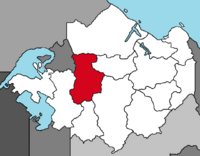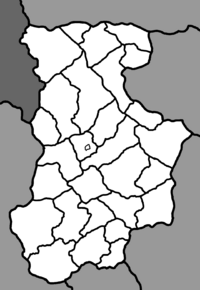Greuningia
Greuningia
Greuningen | |
|---|---|
 Greuningia located in Besmenia | |
| Country | Besmenia |
| Capital | Richtersberg |
| Government | |
| • Type | Parliamentary republic, partially sovereign member state of a federal state |
| • Body | State Chamber of Greuningia |
| • Governor | Linda Seidenbach (NBP) |
| • Governing parties | NBP/BVP |
| • Federal Senate votes | 5 (of 64) |
| Population (2021) | |
| • Total | 5,754,660 |
Greuningia (Besmenian: Greuningen) is a federal state located in Besmenia.
Geography
Greuningia is located in western Besmenia. The state borders Sedakania to the north, Jakartaburg to the northeast, Maurenmark to the southeast, Zollingia to the south, Frankenburg to the southwest and Xevus to the northwest.
Population
History
Since 1967
With the Besmenian reunification on September 14, 1967, the state of Greuningia was re-established. It originated from the West Besmenian districts of Richtenberg and Köstritz, as well as parts of the districts of Ochsenbeinfurt and Halsholm. Richtersberg became the state capital. On September 24, 1967, state elections were held for the first time in Greuningia and in the other federal states in the area of the former West Besmenia. After the 1967 state election, an SDU-BRP government was formed.
Economically, like the other West Besmenian states, Greuningia fared less well in the late 1960s and early 1970s, with Greuningia experiencing the highest unemployment rate in West Besmenia, resulting to the development of the BVP and BRP as the two dominated parties in Greuningia in the 1970s. On November 1, 1969, the Greuningian Constitution came into force.
Politics
Executive
The executive is led by the state government of Greuningia, which consists of the Greuningian governors and the state ministers. The governor is elected by the state chamber with a majority of its members without debate in a secret ballot for the entire legislative period. The governor appoints and dismisses state ministers. He also appoints a state minister as his deputy. The state chamber can only depose the governor through a constructive vote of no confidence.
Legislature
The legislature is the State Chamber of Greuningia, which is elected every five years using the proportional representation. The Greuningian parliament consists of 107 members. All voters who have reached the age of 18 have the right to vote. All parties with more than five percent of the votes are represented in the state parliament.
Greuningian state government
|
Governors of Greuningia since 1967 | ||||||
| No. | Portrait | Name | Term of office | Political party | Election | |
| 1 | File:Wilhelm Schröder.png | Wilhelm Schröder (1900-1970) |
1 November 1967 |
22 February 1970 † |
SDU | 1967 |
| 2 | File:Holger Spahnmann.png | Holger Spahnmann (1913-1995) |
22 February 1970 |
23 November 1971 |
SDU | - |
| 3 | File:Günther Hauknecht.png | Günther Hauknecht (1919-2006) |
23 November 1971 |
7 January 1978 |
BVP | 1971 1975 |
| 4 | 
|
Ulrich Klinker (1930-) |
7 January 1978 |
14 October 1990 |
BVP | May 1978 October 1978 1983 1988 |
| 5 | 
|
Bernhard Weber (1941-) |
14 October 1990 |
12 November 1998 |
BVP | 1993 |
| 6 | 
|
Alexander Wiest (1947-2011) |
12 November 1998 |
28 November 2008 |
NBP | 1998 2003 |
| 7 | 
|
Albrecht Jungmann (1949-) |
28 November 2008 |
20 June 2022 |
BVP | 2008 2013 2018 |
| 8 | 
|
Markus Krüger (1970-) |
20 June 2022 |
10 November 2023 |
BVP | - |
| 9 | 
|
Linda Seidenbach (1992-) |
10 November 2023 |
Incumbent | NBP | 2023 |
List of Greuningian state governments
| No. | State government | Tenure | Governor | Involved Parties |
|---|---|---|---|---|
| 1. | Schröder | 1967–1970 | Wilhelm Schröder (SDU) | SDU, BRP |
| 2. | Spahnmann | 1970–1971 | Holger Spahnmann (SDU) | |
| 3. | Hauknecht I | 1971–1975 | Günther Hauknecht (BVP) | BVP, BRP |
| 4. | Hauknecht II | 1975–1978 | ||
| 5. | Klinker I | 1978–1983 | Ulrich Heberwein (BVP) | BVP |
| 6. | Heberwein II | 1983-1988 | BVP, FBBP | |
| 7. | Klinker III | 1988-1990 | ||
| 8. | Weber I | 1990-1993 | Bernhard Weber (BVP) | |
| 9. | Weber II | 1993-1998 | BVP, FBBP, GPB | |
| 10. | Wiest I | 1998-2003 | Alexander von Wiest (NBP) | NBP, BVP |
| 11. | Wiest II | 2003-2008 | ||
| 12. | Jungmann I | 2008-2013 | Albrecht Jungmann (BVP) | BVP, SDU |
| 13. | Jungmann II | 2013-2018 | BVP, FBBP | |
| 14. | Jungmann III | 2018-2022 | ||
| 15. | Krüger | 2022-2023 | Markus Krüger (BVP) | |
| 16. | Seidenbach | 2023- | Linda Seidenbach (NBP) | NBP, BVP |
Legislature
The legislature is the State Chamber of Greuningia, which is elected every five years using the proportional representation. The Greuningian parliament consists of 107 members. All voters who have reached the age of 18 have the right to vote. All parties with more than five percent of the votes are represented in the state parliament.
Local government
Greuningia is divided into 29 districts (Landbezirk).
Political development
Greuningia is considered to be a rather conservative state, especially in rural areas, and has been dominated by the BVP at the state political level since the 1970s. From 1971, the BVP was involved in every state government in Greuningia.
The right-wing populist BRP also succeeded in influencing regional politics in the first decades after Greuningia joined the Besmenian Federal Republic. The BRP was involved from 1967 to 1978 as a junior partner in the Greuningian state government. When the BRP formed into the NBP in 1990, the NBP, like its predecessor, continued to win numerous voters in Greuningia, especially through the then NBP chairman and native Greuningian Alexander Wiest, who was also chairman of the regional association of the NBP in Greuningia. In the 1998 and 2003 state elections, the NBP even became the strongest party. Between 1998 and 2008 Alexander Wiest served as governor of Greuningia.
Economy
Greuningia processed the economic structural change after 1967 with success and setbacks at the same time. The large combines had serious structural difficulties in the transition to the social market economy, since their technical systems were mostly completely outdated, were characterized by a high use of labor and caused serious environmental damage. In particular, the mechanical engineering, chemical triangle, and mining combines collapsed rapidly after the West Besmenian Revolution, resulting in the loss of tens of thousands of jobs. Unemployment rose from 10.3% in 1968 to 15.1% in 1970, peaking at 18.7% in 1972 and staying there until 1976.


